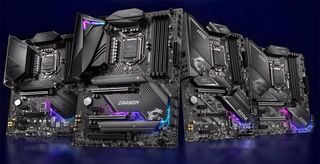I just got Rickrolled by an electron-blasted silicon wafer
Here's what happens when you beam Electrons at a tiny wafer... Rick Astley shows up, apparently.
Holy Electrons, I didn't expect to get hit by a 20-year-old meme today, let alone in the form of Electron-beam lithography. Zachary Tong of the Breaking Taps Youtube channel has broken out the ancient rite of the Rickroll in their latest video outlining this fascinating technique for printing nano-scale images on tiny wafers (via Hackaday).
The process of Electron-beam Lithography (EBL) involves taking a silicon wafer and blasting it with electrons inside a vacuum chamber to create patterns in the wafer's acrylic coating, essentially it will "chop up the long polymer chains into short monomer chains" in order for them to be more easily dissolved when in development.
Tong actually utilised his scanning electron microscope (SEM) as an improvised EBL machine. It's a common technique since SEM's contain a lot of the same components as your average EBL machine, just on a much smaller scale. Still, I don't imagine anyone else has used it as a Rickroll medium just yet.
Of course, using a modded SEM means Tong is limited to using tiny wafers—nothing like the 300mm semiconductor wafers we see in large-scale manufacturing today—and the process is a lot slower. Although he explains that EBL machines are pretty slow themselves. As such, they're "mostly only seen in labs and other research institutions where you don't really care about the throughput of your process, you just want really fine resolution."
Resolution is one of the main hurdles Tong struggled with in testing. Underexposure and overexposure really mess with the fidelity of these nano-scale Rickrolls, and had been a huge issue in his earlier tests—overexposure being something I'm sure Mr. Astley is all too familiar with. Tong notes that "parts of the pattern expose really nicely and you get good, crisp lines, and then other parts get totally blown out and you don't have any definition at all."


Best gaming motherboard: the best boards around
Best AMD motherboard: your new Ryzen's new home
Overexposure tends to be caused by something called the "proximity effect." It happens in really dense pattern areas and is caused by electrons scattering, and unintentionally developing the surrounding areas. In other mediums you'd call it bleed, I guess, and it can actually cause the features to delaminate off the wafer.
All that talk of overexposure gives a great indication as to why it's taken so long to shrink semiconductors down to the miniscule 5nm transistors we see today in the likes of AMD's Ryzen 9 7950X and the 4nm transistors in Nvidia's RTX 4090.
The biggest gaming news, reviews and hardware deals
Keep up to date with the most important stories and the best deals, as picked by the PC Gamer team.
Anyway, Tong's video is a great starting point if you're looking to learn what goes into making a cutting-edge gaming CPU. He explains in such depth, but in simple terms that Rickroll-enjoyers like me can actually follow along with.

Screw sports, Katie would rather watch Intel, AMD and Nvidia go at it. Having been obsessed with computers and graphics for three long decades, she took Game Art and Design up to Masters level at uni, and has been rambling about games, tech and science—rather sarcastically—for four years since. She can be found admiring technological advancements, scrambling for scintillating Raspberry Pi projects, preaching cybersecurity awareness, sighing over semiconductors, and gawping at the latest GPU upgrades. Right now she's waiting patiently for her chance to upload her consciousness into the cloud.
Most Popular







